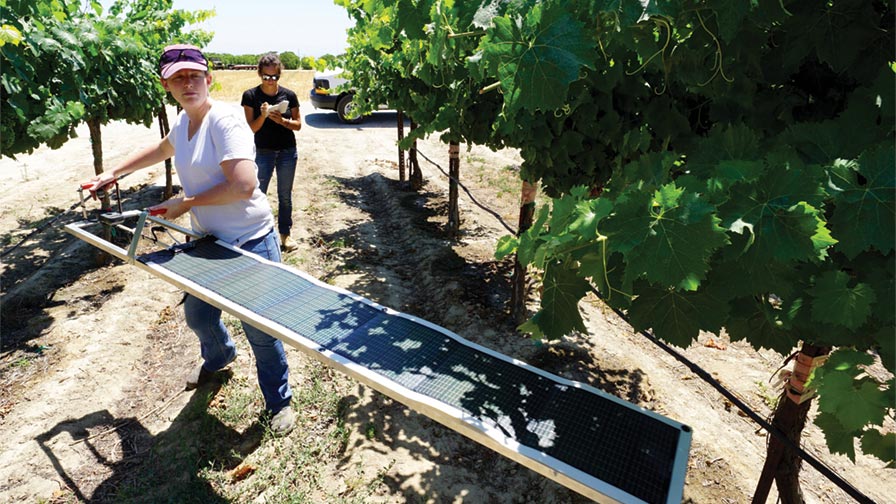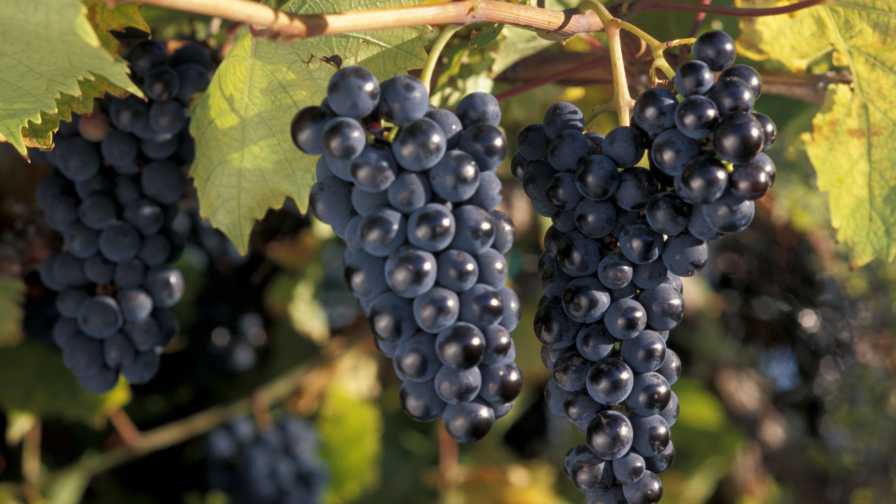Managing Water In California Vineyards

UC Cooperative Extension Viticulture Advisor Lindsay Jordan installs a solar “Paso Panel.” (Photo Credit: Matthew Fidelibus)
The 67th annual meeting of the American Society of Enology and Viticulture (ASEV) highlighted the excellent progress that has been made in vineyard irrigation management since the 1980s, and it hinted at exciting new developments yet to be fully realized.
The symposium was recently held in Monterey, CA. Monterey County, like most of California, remains under severe to exceptional drought conditions, so it was fitting that the meeting began with a symposium on water management.
Internationally recognized speakers from academia and industry discussed a broad range of relevant topics, including water policy, plant physiology, measurement of vine water use, and salinity management. A complete review of the symposium topics is not possible due to space constraints, so in this month’s column I will review some of the presentations on estimating vine water use for improved irrigation scheduling.
Rick Snyder, Biometeorology Specialist Emeritus, University of California, Davis, reviewed historical technologies that have been, and are being, used to estimate vine water use, and discussed emerging technologies that are likely to be widely used in the future.
Snyder began by identifying the various possible inputs and losses of water from vineyards and noted that in most California vineyards, irrigation accounts for most of the water inputs during the growing season, and evapotranspiration (ET), the water lost to evaporation from the soil and plants and transpired from the plant’s leaves, is the primary mechanism of water loss. Therefore vineyard irrigation requirements can be estimated, in part, by determining ET.
Reference ET (ETo ) can be calculated from weather station data and, in the early 1980s, the University of California and the California Department of Water Resources developed a statewide system of weather stations, (California Irrigation Management Information System, (CIMIS), which collect the necessary data, compute ETo, and make it freely accessible on the internet: http://www.cimis.water.ca.gov.
Reference ETo from the nearest CIMIS station can be used to estimate evapotranspiration (ETc) from a well-watered vineyard by multiplying ETo x Kc, the grape crop coefficient.
Another speaker at the symposium, Larry Williams, Professor of Viticulture, UC-Davis, used a weighing lysimeter, a huge scale, to determine actual ET from two vines growing in what was essentially a giant pot.
Having measured crop ET (ETc) with the lysimeter, and using calculated ETo, he and his collaborator and fellow symposium speaker, USDA-Agricultural Research Service Agricultural Engineer James Ayars, calculated Kc daily (Kc = ETc/ETo) and found it to be linearly correlated with percent vineyard shaded area at midday. This observation led to the discovery that Kc of grape was a linear function of percent mid-day shaded area of the vineyard; , specifically, Kc = -0.007 + (0.017 x percent shaded area).
Williams’ work was a breakthrough because it provided an objective and relatively easy way to estimate the water use of a well-watered vineyard regardless of row spacing or trellis size.
All that is needed is an estimate of shaded area, which can be achieved in a number of relatively low-tech ways, including counting the shaded squares on a grid under the vines, or using a “Paso Panel” solar panel device developed by UC Viticulture Farm Advisor Mark Battany (also a speaker at the symposium).
It should be noted that providing vines with 100% ETc is not necessarily desirable as research has shown that vines can often be deficit-irrigated (provided with < 100% ETc) without sacrificing yield or quality. Several of Williams’ studies have suggested 70% ETc is often sufficient.
Williams’ equation to estimate ETc has been widely adopted by growers throughout California and the world and it remains the standard by which other measures of vineyard water use are compared. However, Snyder identified several situations where, in his opinion, use of the shaded area method to develop a Kc may be problematic.
For example, vineyards on slopes, and possibly vineyards with different row orientations, as row orientation can affect sunlight interception by vines in the vineyard. For these reasons and others, including the potential for automation, Snyder and his colleagues are working to perfect the use of “surface renewal” technology which will enable direct measurement of ETc in a vineyard.
In short, stay tuned for exciting new developments in vineyard irrigation management in the very near future.










